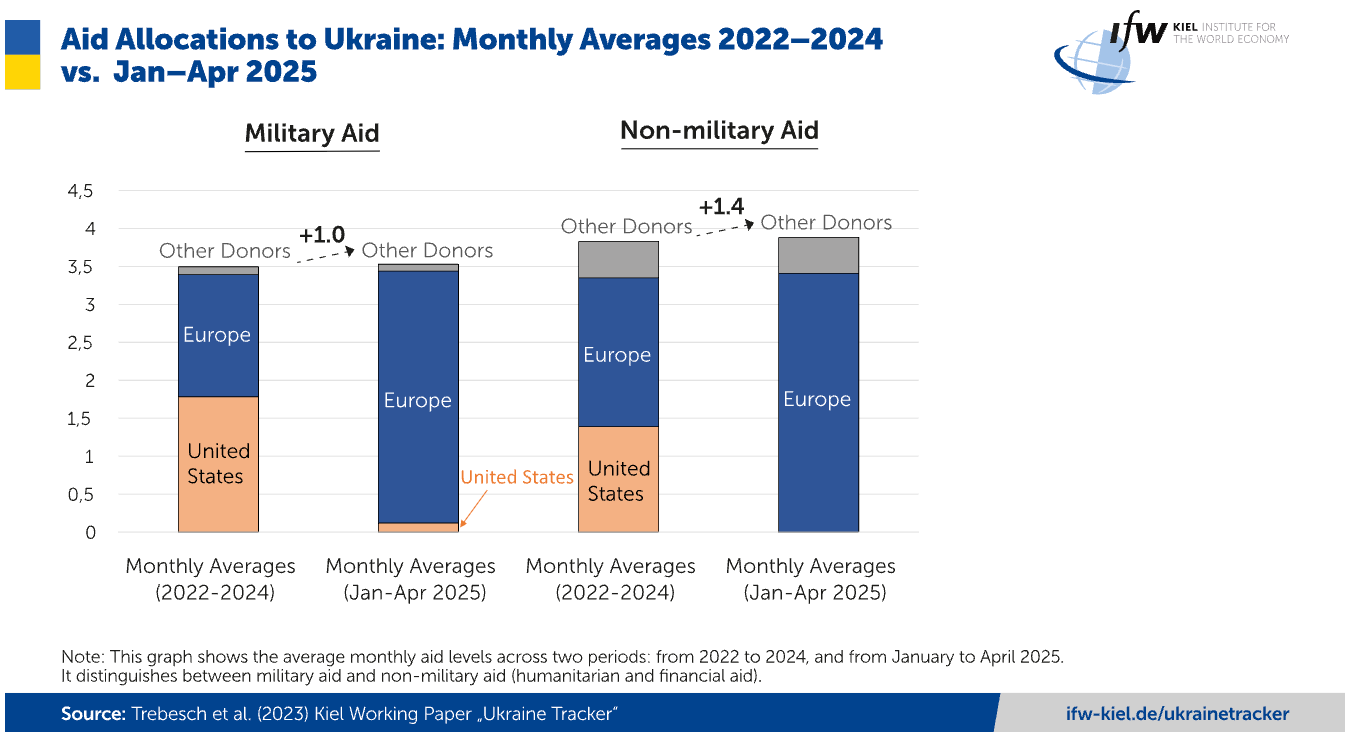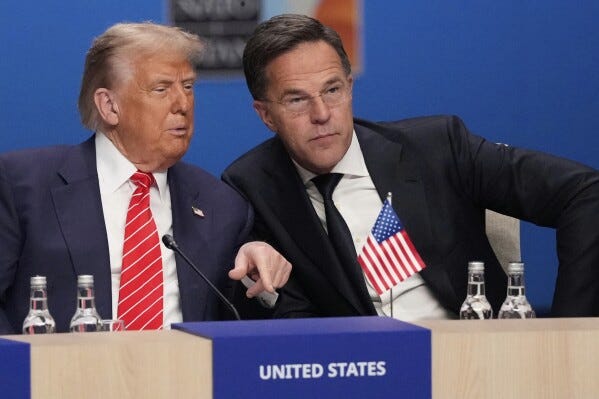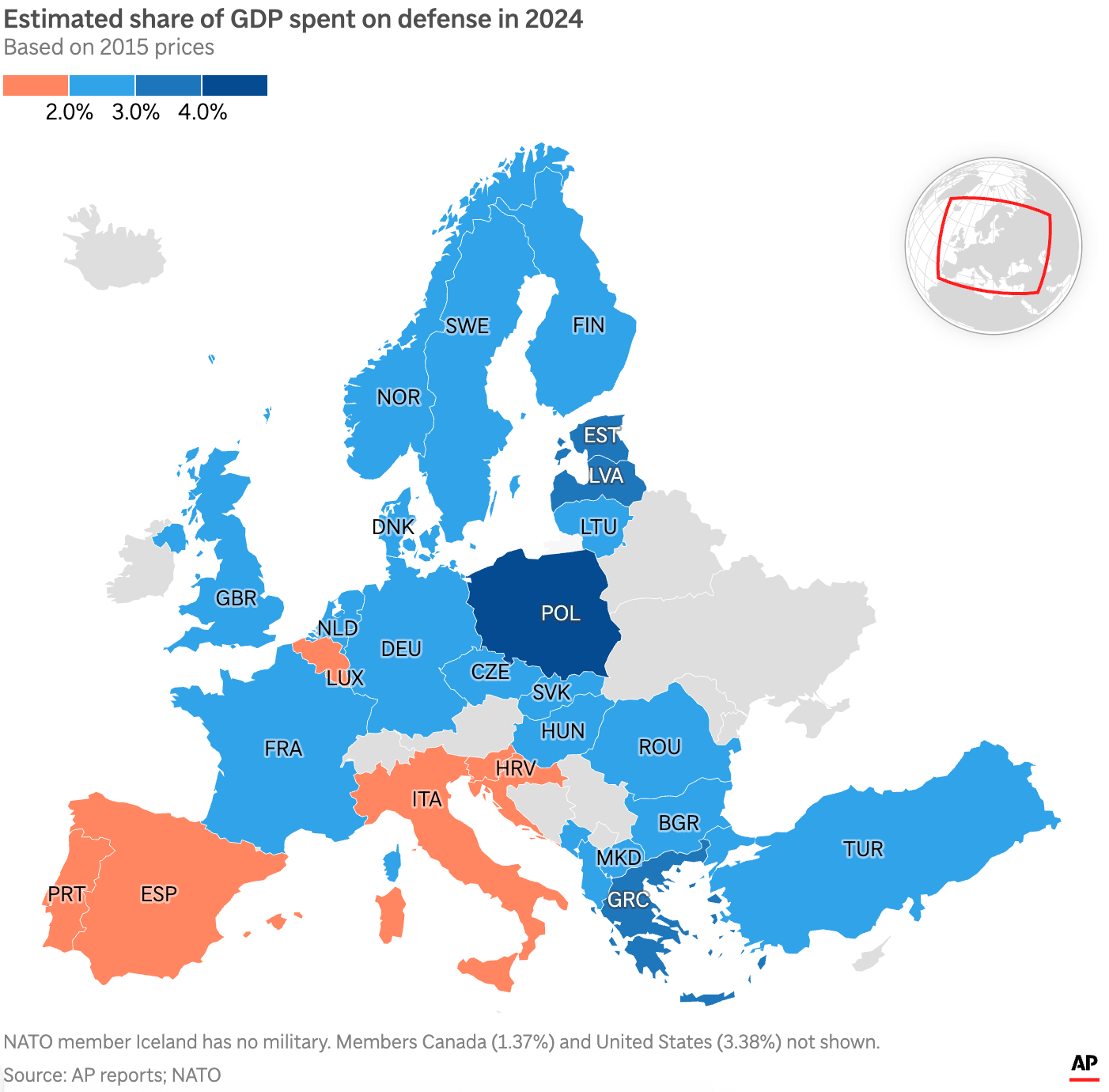What happened at the NATO summit?
A largely smooth event that papered over national differences.
The media is focused squarely on two stories, one much more impactful than the other.
The impactful story: Trump and Republican’s epically unpopular 900+ page budget that represents an unmitigated disaster for Americans across the country (current projection: 17mn people will lose health insurance), as well as future generations (through, amongst other things, piling on mountains of debt and subsidizing investment in metallurgical coal).
The narrative story: The New York City Democratic mayoral primary, the result of which has produced a mountain of think pieces dissecting and diagnosing what Zohran Mamdani’s win means for New York City, the Democratic Party and 2028.
But just because the US is concentrating on its own future right now while also getting ready to celebrate its past — Happy 249th birthday — that doesn’t mean the rest of the world shut down.
According to the Ukrainian Air Force, this past weekend (June 28) Russia embarked on its largest strike on Ukraine since the start of the invasion, launching 537 drones and missiles in one night. Ukraine’s president Volodymyr Zelenskyy noted just how relentless Moscow’s campaign has recently been.
“Just this week alone, there have been more than 114 missiles, over 1,270 drones, and nearly 1,100 glide bombs,” Zelenskyy said. “Putin long ago decided he would keep waging war, despite the world’s calls for peace.”
Data gathered by the Associated Press through the Ukrainian Air Force shows that Russia has stepped up its drone attacks, and more are penetrating Ukraine’s defenses.

Per data from the Kiel Institute, which has been tracking aid flows into Ukraine since the start of this war in 2022, Europe (behind increased flows from the Nordics and the UK) upped its support for Kyiv in March and April 2025, while at the same time the US stoped allocating new aid.
Additional support in 2025 from Europe has offset the gap exposed by the essentially zeroing out of support from the Trump administration.

As presented below, the Biden administration made one final push for support in the fourth quarter of 2024. Since then, US-allocated aid has trickled to a halt.

Trump met with Zelenskyy at the NATO summit last week, and the two had a fairly cordial encounter. But just today, it was reported that last month the US stopped sending some high-value weapons, including those used in defense systems, to Ukraine which one insider claimed were already en route. Per one Ukrainian official who spoke to the FT, “‘We counted on many of those systems as they were promised…that significantly affects our planning.”
It is against this backdrop that we look today at last week’s NATO summit.
The Trump whisperer
Last year, the long-time former prime minister of the Netherlands Mark Rutte was appointed NATO’s new secretary-general. Back in the halcyon days of 2017-2020, Rutte developed a reputation as something of a “Trump whisperer.”1 And with the possibility that Trump was about to return to the White House, it was only logical that Rutte would ascend to the top of the NATO org chart. At least nominally speaking, because while NATO may be a collective alliance, it is steered largely by its most powerful member, the United States.
Mark Rutte with Trump

Trump has long been a NATO skeptic. Even before he took office in January, Trump was musing about demanding NATO members’ increase their defense spending targets from 2% to 5% of GDP and threatening to rescind US support if other members didn’t step up.
Last year, only Poland and Estonia spent more on defense as a % of GDP than the US.
But in terms of overall burden share among NATO members, the gross amount spent, the US stands head and shoulders above the rest.
Which chart below do you think Trump sees when he is steaming over NATO being unfair and ripping off the US?

Notably, the US spends just under 3.5% of GDP on defense, but Trump has previously argued that because of its largesse, the US does not need to conform with his proposed reform.
Differences in opinion
Even before the Trump of it all though, there are real tensions inherent within NATO, largely down to geography.
Some members, like the Baltic states of Estonia, Latvia, and Lithuania which are more exposed to possible future Russian aggression, are more ambitious and have already announced plans to increase defense spending by over 5% by the end of the decade.
But as one of the more insulated members (at least, from Russia), Spain has been a leading laggard. In the run-up to this year’s summit, Spain’s prime minister Pedro Sanchez complained that spending 5% of GDP on defense was an infringement on Spanish sovereignty and could weaken Spain’s socio-political environment by increasing debt and diverting investment from more urgent public services. Sanchez argued that Spain would spend ~2.1% of GDP on defense, barely clearing the previous threshold of 2%.
Mapping out NATO spending. Countries that border Russia are generally more committed to defense while southern Europe is more sanguine.

To be fair to Sanchez, even the idea of spending 2% of GDP on defense is relatively new, having been agreed at the 2014 summit in Wales. Yet, it wasn’t until faced with the reality of Russia’s invasion of Ukraine in 2022, and the imminent threat Putin posed, that most member-states successfully hit the 2% spending threshold.
While some member states, like the Baltic states and Scandinavia have increased their defense commitment following Russia’s invasion, southern European countries have been slower to respond.

The compromise
These contrasting visions gave Rutte a lot of navigate. In the months preceding this year’s summit, Rutte tried to meet Trump where he was while also accommodating leaders like Sanchez who are not as enthusiastic about large defense commitments. To do so, Rutte proposed NATO members increase core military spending to 3.5% and invest another 1.5% on defense and security-related programs like infrastructure (e.g., tunnels, bridges and ports) and cyber-security.
The logic was, Trump can claim a win with a simple round number (5%) he can broadcast on TV and social media, while at the same time European leaders can be more flexible in how they choose to allocate their budgets.
At last week’s summit, all 32 member-states signed off on the agreement saying that ‘allies’ were committed to investing 5% of GDP by 2035 “to ensure our individual and collective obligations.” Here, the word ‘allies’ is doing a lot of work. One could read this as not saying ‘we’ or ‘all allies,’ so presumably not everyone needs to hit the 5% threshold, allowing Sanchez to secure Spain an opt-out from the 5% spending threshold, much to Trump’s annoyance.
Perhaps more importantly, the agreement includes a plan to review spending in 2029. This spending review will be undertaken “in light of the strategic environment and updated Capability Targets.”
Why does the date matter? Because in 2029, there will (presumably) be a new President of the United States, who may (or may not) be more hospitable to Europe and multilateral alliances.
The meeting
Despite worries that he might do something dramatic and consequential in the Hague, Trump was pretty subdued, perhaps because the event was largely tailored to his style.
Instead of two full days worth of meetings, this summit was oriented around one, 2.5 hour meeting focused on defense spending.
This year’s output was a one-page, five-bullet point declaration as opposed to last year’s 15-page text or the 22-pages that made up 2023’s document.2
And as an avowed lover of all things the UK Royal Family, he was even hosted by the Dutch royal family (sleepover included).
The result? Rather than rail against Europe, Trump recommitted the US to NATO, saying that “we’re with them all the way.” But considering the pendulum swing that is Trump’s decision-making, whether that commitment is firm is certainly up for debate.
******************
How realistic though are these spending increases, really? In it’s write-up on the event, the Stockholm International Peace Research Institute noted that spending 5% on defense is going to massively stretch national budgets beyond what governments and citizens are used to.
Looking at some individual countries, Germany would need to spend approximately $329 billion in 2035 in order to reach 5 per cent, France $221 billion and Italy $158 billion. For context, estimated public spending on education in these countries currently stands at around $283 billion, $225 billion and $126 billion, respectively.
Is Europe prepared for that? We’ll discuss in a future post.
Note at the bottom: a rather odd statement
One final point about the NATO summit.
Like many other news agencies, the conservative-leaning Washington Times (not The Washington Post), was covering Trump’s trip last week. A headline from one of their published stories was:
Trump says Iranians asked U.S. what time they could bomb American military base in Qatar
That seems rather odd. Let’s see what it has to say.
President Trump said Iranian leaders cleared their plan with the U.S. to fire retaliatory strikes against an American airbase in Qatar, and even requested a specific time to attack.
“They said, ’We’re going to shoot them. Is one o’clock OK?’ I said it’s fine. And everybody was emptied off the base so they couldn’t get hurt, except for the gunners,” Mr. Trump said at a press conference in the Netherlands, where he is attending a NATO summit.
Monday’s Iranian attack on Al Udeid Air Base, the largest U.S. military installation in the region, was repelled by missile defense batteries, and there were no casualties, the Pentagon said.
So basically, if I am to understand this correctly, Trump gave Iran permission to fire at an American military base? A story from the non-partisan Military.com notes just how strange this seems within the Pentagon.
The casual, nonchalant tone of Trump's acceptance that Iran would attack U.S. forces at Al Udeid Air Base in Qatar -- an assault that involved more than a dozen Iranian missiles -- was a sharp contrast to the message of steely-eyed professionalism and heroism that his top military adviser, Joint Chiefs Chairman Gen. Dan Caine, offered to reporters the next day for what he said was likely the largest single use of the Patriot air defense system in U.S. history.
[…]
Privately, many officials within the Pentagon struggled to explain the president's remarks, though some pointed to his history of bluster and exaggeration.
One defense official said that military leaders in the Pentagon didn't believe that the president provoked or allowed the attack to occur and that the Iranians were always going to look for a way to conduct a proportionate response to the U.S. strikes on their nuclear sites.
A report by the journalist Sarah Posner notes that there has been virtually no coverage of Trump’s statement.
Now, maybe you think this isn’t that big of a deal. No one was hurt, right now it seems Iran has ‘gotten retaliation out of its system’ and everyone has moved on (the Google Trends data on search interest in Iran is stunning). Maybe Trump was simply exaggerating for effect, as is his wont.
But what if this is true, and we hadn’t been as fortunate? What if someone had gotten hurt or even killed because of these strikes?
It doesn’t matter that no one got hurt, or that the defense system was more than capable of taking down Iran’s missiles.
The ends don’t always justify the means, especially when lives are at stake.
If you enjoyed this edition of Nuance Matters, consider letting me know by buying me a cup of coffee!
Cheers!
An idea no doubt reinforced by recent events, including Trump’s posting to Truth Social text message from Rutte overly praising the US President.

The short declaration did not mention China.



